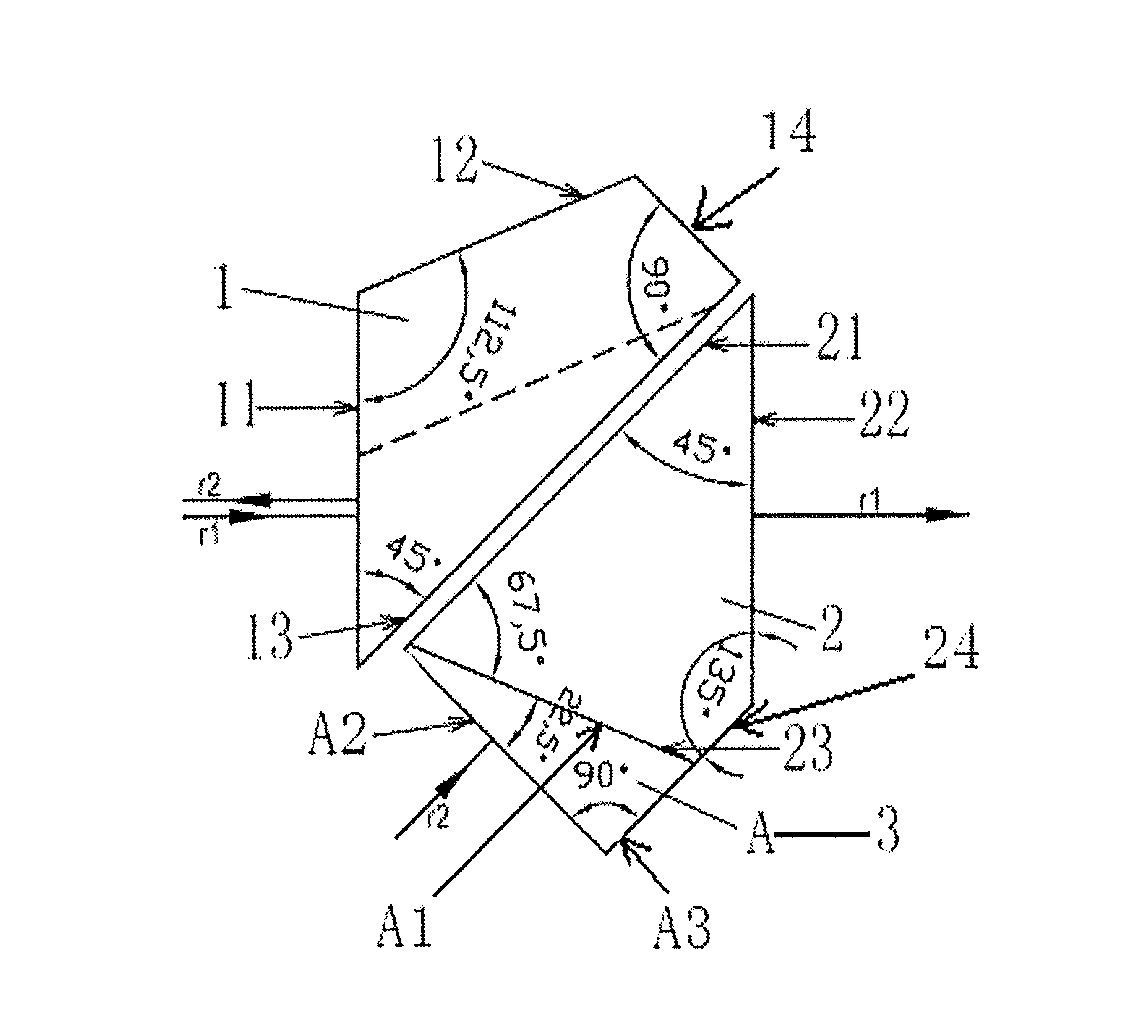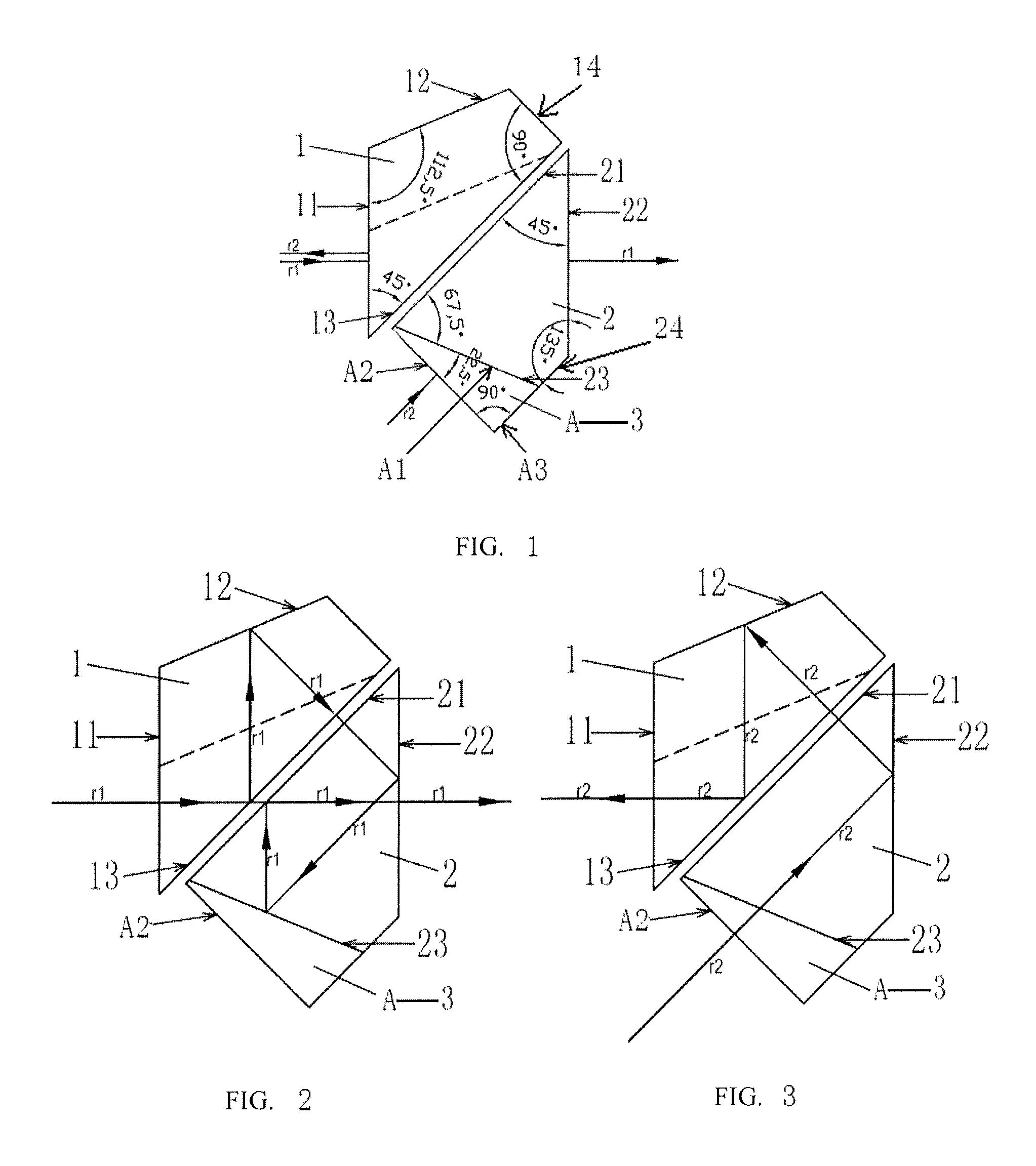Beam splitting system for laser ranging
a beam splitting and laser rangefinder technology, applied in distance measurement, surveying and navigation, instruments, etc., can solve the problems of large size, difficult installation and debugging, complicated structure of optical beam splitters of laser rangefinders, etc., to reduce the size of optical beam splitters, reduce the influence of transparent objects, and high stability and reliability
- Summary
- Abstract
- Description
- Claims
- Application Information
AI Technical Summary
Benefits of technology
Problems solved by technology
Method used
Image
Examples
embodiment 1
[0040] A beam splitting system for laser ranging is provided, referring to FIGS. 1, 2 and 3, including: a roof half-pentaprism (1), an isosceles prism (2) and a compensating prism (3), where the compensating prism is a compensating prism I (A).
[0041]The roof half-pentaprism includes a roof transceiving surface (11), an outer roof reflecting surface (12), an inner roof reflecting surface (13) and a top roof surface (14). Two ends of the roof transceiving surface are intersected with one end of the outer roof reflecting surface and one end of the inner roof reflecting surface, respectively. Two ends of the top roof surface are intersected with the other end of the outer roof reflecting surface and the other end of the inner roof reflecting surface, respectively. An included angle between the outer roof reflecting surface and the roof transceiving surface is 112.5°. An included angle between the roof transceiving surface and the inner roof reflecting surface is 45°. An included angle b...
embodiment 3
[0050] Referring to FIG. 10, the difference between FIG. 10 and FIG. 4 lies in that: first, the optical beam splitter (100) in the transceiving system I (107) in FIG. 4 is replaced with an optical beam splitter (200), the compensating prism (3) of the optical beam splitter (200) is a compensating prism II (B), and the compensating prism II includes a first compensation transceiving surface II (B3) and a second compensation transceiving surface II (B4); second, the combined lens (110) and the receiver (102) are disposed on one side opposite to the first compensation transceiving surface II of the compensating prism II (B), and the combined lens (110) is disposed between the first compensation transceiving surface II (B3) and the receiver (102); and third, a group of combined reflecting lens (111) are disposed on one side opposite to the second compensation transceiving surface II of the compensating prism II (B), and the LCD (101) is disposed in front of the reflecting surfaces of th...
embodiment 5
[0054] Referring to FIG. 16, the difference between FIG. 16 and FIG. 10 lies in that: first, the optical beam splitter (200) in the transceiving system I (107) in FIG. 10 is replaced with an optical beam splitter (300), the compensating prism (3) of the optical beam splitter (300) is a compensating prism III (C), and the compensating prism III includes a first compensation transceiving surface III (C2) and a second compensation transceiving surface III (C3); second, the combined lens (110) and the receiver (102) are disposed on one side opposite to the second compensation transceiving surface III (C3) of the compensating prism III (C), and the combined lens (110) is disposed between the second compensation transceiving surface III (C3) and the receiver (102); and third, a group of combined reflecting lens (111) are disposed on one side opposite to the first compensation transceiving surface III of the compensating prism III (C), and the LCD (101) is disposed in front of the reflecti...
PUM
 Login to View More
Login to View More Abstract
Description
Claims
Application Information
 Login to View More
Login to View More - R&D
- Intellectual Property
- Life Sciences
- Materials
- Tech Scout
- Unparalleled Data Quality
- Higher Quality Content
- 60% Fewer Hallucinations
Browse by: Latest US Patents, China's latest patents, Technical Efficacy Thesaurus, Application Domain, Technology Topic, Popular Technical Reports.
© 2025 PatSnap. All rights reserved.Legal|Privacy policy|Modern Slavery Act Transparency Statement|Sitemap|About US| Contact US: help@patsnap.com



